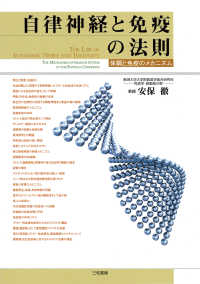- ホーム
- > 洋書
- > 英文書
- > Computer / General
Full Description
This book aims to provide a comprehensive overview of the applications of Artificial Intelligence (AI) in the area of Cybersecurity and Digital Forensics. The various chapters of this book are written to explore how cutting‑edge technologies can be used to improve the detection, prevention, and investigation of cybercrime and help protect digital assets.
Digital Defence covers an overview of deep learning and AI techniques and their relevance to cybersecurity and digital forensics, discusses common cyber threats and vulnerabilities, and how deep learning and AI can detect and prevent them. It focuses on how deep learning/artificial learning techniques can be used for intrusion detection in networks and systems, analyze and classify malware, and identify potential sources of malware attacks. This book also explores AI's role in digital forensics investigations, including data recovery, incident response and management, real‑time monitoring, automated response analysis, ethical and legal considerations, and visualization. By covering these topics, this book will provide a valuable resource for researchers, students, and cybersecurity and digital forensics professionals interested in learning about the latest advances in deep learning and AI techniques and their applications.
Contents
Chapter 1 ◾ Artificial Intelligence for Cybersecurity—Fundamentals and Evaluation
Rasmita Kumari Mohanty, Satya Prakash Sahoo, Manas Ranjan Kabat, and Basim Alhadidi
Chapter 2 ◾ Predicting Tomorrow's Threats: A Legal Framework for AI‑Based Predictive Analytics in Cybersecurity
Sarvesh Nimbulkar and Souradeep Rakshit
Chapter 3 ◾ The Invisible Defence: Detecting Zero‑Day Threats with AI
Debojyoti Gupta
Chapter 4 ◾ Fusion of Deep Architectures in Intent‑Driven Networks for Intrusion Detection
Obinna Johnbosco Awoke, Rajesh Prasad, Ndubuisi Godcares, and Najeeb Saiyed
Chapter 5 ◾ An In‑depth Analysis of Intrusion Detection Systems with an Emphasis on Multi‑Access Edge Computing and Machine Learning
Shruti Saxena and Nikunj Tahilramani
Chapter 6 ◾ The Legal and Ethical Crossroads of Artificial Intelligence in Cybersecurity and Digital Forensics
Gyanendra Tiwari, Khushi Pandey, Manali Desai, Vinayak Musale, Dhanashri Wategaonkar, and Mangesh Bedekar
Chapter 7 ◾ Multi‑Factor Authentication for Smart Internet Transactions
B. Madhu, B.N. Shubhada, and Shubham Kumar Saras
Chapter 8 ◾ Adaptive Machine Learning Strategies for Next‑Generation Botnet Host Detection
Aniket Jhariya, Dhvani Parekh, Anurag Mogal, Joshua Lobo, and Mangal Singh
Chapter 9 ◾ Artificial Intelligence‑Based Cybercrime Prevention and Data Security
Srinivasa Rao Gundu, Panem Charanarur, and J. Vijaylaxmi
Chapter 10 ◾ Insight into How Legal and Ethical Consideration Improve Artificial Intelligence Capabilities to Enhance the Performance of Cyber Forensic Accounting
Pham Quang Huy and M.A. Vu Kien Phuc







